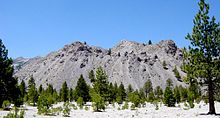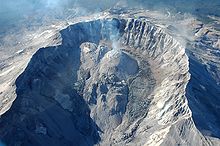Lava dome



Involcanology,alava domeis a circular, mound-shaped protrusion resulting from the slowextrusionofviscouslavafrom avolcano.Dome-building eruptions are common, particularly in convergent plate boundary settings.[1]Around 6% oferuptionson Earth form lava domes.[1]Thegeochemistryof lava domes can vary frombasalt(e.g.Semeru,1946) torhyolite(e.g.Chaiten,2010) although the majority are of intermediate composition (such asSantiaguito,dacite-andesite,present day)[2]The characteristic dome shape is attributed to high viscosity that prevents the lava fromflowingvery far. This high viscosity can be obtained in two ways: by high levels ofsilicain the magma, or bydegassingof fluidmagma.Since viscousbasalticandandesiticdomesweatherfast and easily break apart by further input of fluid lava, most of the preserved domes have high silica content and consist of rhyolite ordacite.
Existence of lava domes has been suggested for some domed structures on theMoon,Venus,andMars,[1]e.g. the Martian surface in the western part ofArcadia Planitiaand withinTerra Sirenum.[3][4]
Dome dynamics[edit]

Lava domes evolve unpredictably, due tonon-lineardynamics caused bycrystallizationandoutgassingof the highly viscous lava in the dome'sconduit.[5]Domes undergo various processes such as growth, collapse, solidification anderosion.[6]
Lava domes grow byendogenicdome growth orexogenicdome growth. The former implies the enlargement of a lava dome due to the influx of magma into the dome interior, and the latter refers to discrete lobes of lava emplaced upon the surface of the dome.[2]It is the high viscosity of the lava that prevents it from flowing far from the vent from which it extrudes, creating a dome-like shape of sticky lava that then cools slowly in-situ.[7]Spinesandlava flowsare common extrusive products of lava domes.[1]Domes may reach heights of several hundred meters, and can grow slowly and steadily for months (e.g.Unzenvolcano), years (e.g.Soufrière Hillsvolcano), or even centuries (e.g.Mount Merapivolcano). The sides of these structures are composed of unstable rock debris. Due to the intermittent buildup of gaspressure,erupting domes can often experience episodes ofexplosive eruptionover time.[8]If part of a lava dome collapses and exposes pressurized magma,pyroclastic flowscan be produced.[9]Other hazards associated with lava domes are the destruction of property fromlava flows,forest fires,andlaharstriggered from re-mobilization of loose ash and debris. Lava domes are one of the principal structural features of manystratovolcanoesworldwide. Lava domes are prone to unusually dangerous explosions since they can contain rhyoliticsilica-rich lava.
Characteristics of lava dome eruptions include shallow, long-period and hybridseismicity,which is attributed to excess fluid pressures in the contributing vent chamber. Other characteristics of lava domes include their hemispherical dome shape, cycles of dome growth over long periods, and sudden onsets of violent explosive activity.[10]The average rate of dome growth may be used as a rough indicator ofmagma supply,but it shows no systematic relationship to the timing or characteristics of lava dome explosions.[11]
Gravitational collapseof a lava dome can produce ablock and ash flow.[12]
Related landforms[edit]
Cryptodomes[edit]

Acryptodome(from theGreekκρυπτός,kryptos,"hidden, secret" ) is a dome-shaped structure created by accumulation ofviscousmagmaat a shallow depth.[13]One example of a cryptodome was in the May1980 eruption of Mount St. Helens,where the explosive eruption began after alandslidecaused the side of the volcano to collapse, leading to explosive decompression of the subterranean cryptodome.[14]
Lava spine/Lava spire[edit]

A lava spine or lava spire is a growth that can form on the top of a lava dome. A lava spine can increase the instability of the underlying lava dome. A recent example of a lava spine is the spine formed in 1997 at theSoufrière Hills Volcanoon Montserrat.
Lava coulées[edit]

Coulées (or coulees) are lava domes that have experienced some flow away from their original position, thus resembling both lava domes andlava flows.[2]
The world's largest knowndaciteflow is theChao dacite dome complex,a huge coulée flow-dome between two volcanoes in northernChile.This flow is over 14 kilometres (8.7 mi) long, has obvious flow features like pressure ridges, and a flow front 400 metres (1,300 ft) tall (the dark scalloped line at lower left).[15]There is another prominent coulée flow on the flank ofLlullaillacovolcano, inArgentina,[16]and other examples in theAndes.
Examples of lava domes[edit]
| Name of lava dome | Country | Volcanic area | Composition | Last eruption or growth episode |
|---|---|---|---|---|
| Chaitén lava dome | Chile | Southern Volcanic Zone | Rhyolite | 2009 |
| Ciomadullava domes | Romania | Carpathians | Dacite | Pleistocene |
| Cordón Caullelava domes | Chile | Southern Volcanic Zone | Rhyodaciteto Rhyolite | Holocene |
| Galeraslava dome | Colombia | Northern Volcanic Zone | Unknown | 2010 |
| Katla lava dome | Iceland | Iceland hotspot | Rhyolite | 1999 onwards[17][better source needed] |
| Lassen Peak | United States | Cascade Volcanic Arc | Dacite | 1917 |
| Black Butte (Siskiyou County, California) | United States | Cascade Volcanic Arc | Dacite | 9500 BP[18] |
| Bridge River Ventlava dome | Canada | Cascade Volcanic Arc | Dacite | ca. 300 BC |
| La Soufrièrelava dome | Saint Vincent and the Grenadines | Lesser Antilles Volcanic Arc | 2021[19] | |
| Mount Merapilava dome | Indonesia | Sunda Arc | Unknown | 2010 |
| Nea Kameni | Greece | South Aegean Volcanic Arc | Dacite | 1950 |
| Novaruptalava dome | United States | Aleutian Arc | Rhyolite | 1912 |
| Nevados de Chillánlava domes | Chile | Southern Volcanic Zone | Dacite | 1986 |
| Puy de Dôme | France | Chaîne des Puys | Trachyte | c. 5760 BC |
| Santa María lava dome | Guatemala | Central America Volcanic Arc | Dacite | 2009 |
| Sollipullilava dome | Chile | Southern Volcanic Zone | Andesiteto Dacite | 1240 ± 50 years |
| Soufrière Hillslava dome | Montserrat | Lesser Antilles | Andesite | 2009 |
| Mount St. Helenslava domes | United States | Cascade Volcanic Arc | Dacite | 2008 |
| Torfajökulllava dome | Iceland | Iceland hotspot | Rhyolite | 1477 |
| Tata Sabayalava domes | Bolivia | Andes | Unknown | ~ Holocene |
| Tate-iwa | Japan | Japan Arc | Dacite | Miocene[20] |
| Tatunlava domes | Taiwan | Andesite | 648[21] | |
| Valles lava domes | United States | Jemez Mountains | Rhyolite | 50,000-60,000BP |
| Wizard Islandlava dome | United States | Cascade Volcanic Arc | Rhyodacite[22] | 2850 BC |
References[edit]
- ^abcdCalder, Eliza S.; Lavallée, Yan; Kendrick, Jackie E.; Bernstein, Marc (2015).The Encyclopedia of Volcanoes.Elsevier. pp. 343–362.doi:10.1016/b978-0-12-385938-9.00018-3.ISBN9780123859389.
- ^abcFink, Jonathan H.; Anderson, Steven W. (2001). "Lava Domes and Coulees". In Sigursson, Haraldur (ed.).Encyclopedia of Volcanoes.Academic Press.pp. 307–19.
- ^Rampey, Michael L.; Milam, Keith A.; McSween, Harry Y.; Moersch, Jeffrey E.; Christensen, Philip R. (28 June 2007)."Identity and emplacement of domical structures in the western Arcadia Planitia, Mars".Journal of Geophysical Research.112(E6): E06011.Bibcode:2007JGRE..112.6011R.doi:10.1029/2006JE002750.
- ^Brož, Petr; Hauber, Ernst; Platz, Thomas; Balme, Matt (April 2015)."Evidence for Amazonian highly viscous lavas in the southern highlands on Mars".Earth and Planetary Science Letters.415:200–212.Bibcode:2015E&PSL.415..200B.doi:10.1016/j.epsl.2015.01.033.
- ^Melnik, O; Sparks, R. S. J. (4 November 1999),"Nonlinear dynamics of lava dome extrusion"(PDF),Nature,402(6757): 37–41,Bibcode:1999Natur.402...37M,doi:10.1038/46950,S2CID4426887
- ^Darmawan, Herlan; Walter, Thomas R.; Troll, Valentin R.; Budi-Santoso, Agus (2018-12-12)."Structural weakening of the Merapi dome identified by drone photogrammetry after the 2010 eruption".Natural Hazards and Earth System Sciences.18(12): 3267–3281.Bibcode:2018NHESS..18.3267D.doi:10.5194/nhess-18-3267-2018.ISSN1561-8633.
- ^Darmawan, Herlan; Troll, Valentin R.; Walter, Thomas R.; Deegan, Frances M.; Geiger, Harri; Heap, Michael J.; Seraphine, Nadhirah; Harris, Chris; Humaida, Hanik; Müller, Daniel (2022-02-25)."Hidden mechanical weaknesses within lava domes provided by buried high-porosity hydrothermal alteration zones".Scientific Reports.12(1): 3202.Bibcode:2022NatSR..12.3202D.doi:10.1038/s41598-022-06765-9.ISSN2045-2322.PMC8881499.PMID35217684.
- ^Heap, Michael J.; Troll, Valentin R.; Kushnir, Alexandra R. L.; Gilg, H. Albert; Collinson, Amy S. D.; Deegan, Frances M.; Darmawan, Herlan; Seraphine, Nadhirah; Neuberg, Juergen; Walter, Thomas R. (2019-11-07)."Hydrothermal alteration of andesitic lava domes can lead to explosive volcanic behaviour".Nature Communications.10(1): 5063.Bibcode:2019NatCo..10.5063H.doi:10.1038/s41467-019-13102-8.ISSN2041-1723.PMC6838104.PMID31700076.
- ^Parfitt, E.A.; Wilson, L (2008),Fundamentals of Physical Volcanology,Massachusetts: Blackwell Publishing, p. 256
- ^Sparks, R.S.J. (August 1997), "Causes and consequences of pressurisation in lava dome eruptions",Earth and Planetary Science Letters,150(3–4): 177–189,Bibcode:1997E&PSL.150..177S,doi:10.1016/S0012-821X(97)00109-X
- ^Newhall, C.G.; Melson., W.G. (September 1983), "Explosive activity associated with the growth of volcanic domes",Journal of Volcanology and Geothermal Research,17(1–4): 111–131,Bibcode:1983JVGR...17..111N,doi:10.1016/0377-0273(83)90064-1
- ^Cole, Paul D.; Neri, Augusto; Baxter, Peter J. (2015). "Chapter 54 – Hazards from Pyroclastic Density Currents". InSigurdsson, Haraldur(ed.).Encyclopedia of Volcanoes(2nd ed.). Amsterdam: Academic Press. pp. 943–956.doi:10.1016/B978-0-12-385938-9.00037-7.ISBN978-0-12-385938-9.
- ^"USGS: Volcano Hazards Program Glossary - Cryptodome".volcanoes.usgs.gov.Retrieved2018-06-23.
- ^"USGS: Volcano Hazards Program CVO Mount St. Helens".volcanoes.usgs.gov.Archived fromthe originalon 2018-05-28.Retrieved2018-06-23.
- ^Chao dacite dome complexatNASA Earth Observatory
- ^Coulées!by Erik Klemetti, an assistant professor of Geosciences atDenison University.
- ^Eyjafjallajökull and Katla: restless neighbours
- ^"Shasta".Volcano World.Oregon State University.2000.Retrieved30 April2020.
- ^"Soufrière St. Vincent volcano (West Indies, St. Vincent): twice length and volume of new lava dome since last update".volcanodiscovery.Retrieved2021-04-08.
- ^Goto, Yoshihiko; Tsuchiya, Nobutaka (July 2004). "Morphology and growth style of a Miocene submarine dacite lava dome at Atsumi, northeast Japan".Journal of Volcanology and Geothermal Research.134(4): 255–275.Bibcode:2004JVGR..134..255G.doi:10.1016/j.jvolgeores.2004.03.015.
- ^"Tatun Volcanic Group".Global Volcanism Program, Smithsonian Institution.2023-10-11.Retrieved2023-11-27.
- ^Map of Post-Caldera Volcanism and Crater LakeArchived2020-08-04 at theWayback MachineUSGS Cascades Volcano Observatory. Retrieved 2014-01-31.

